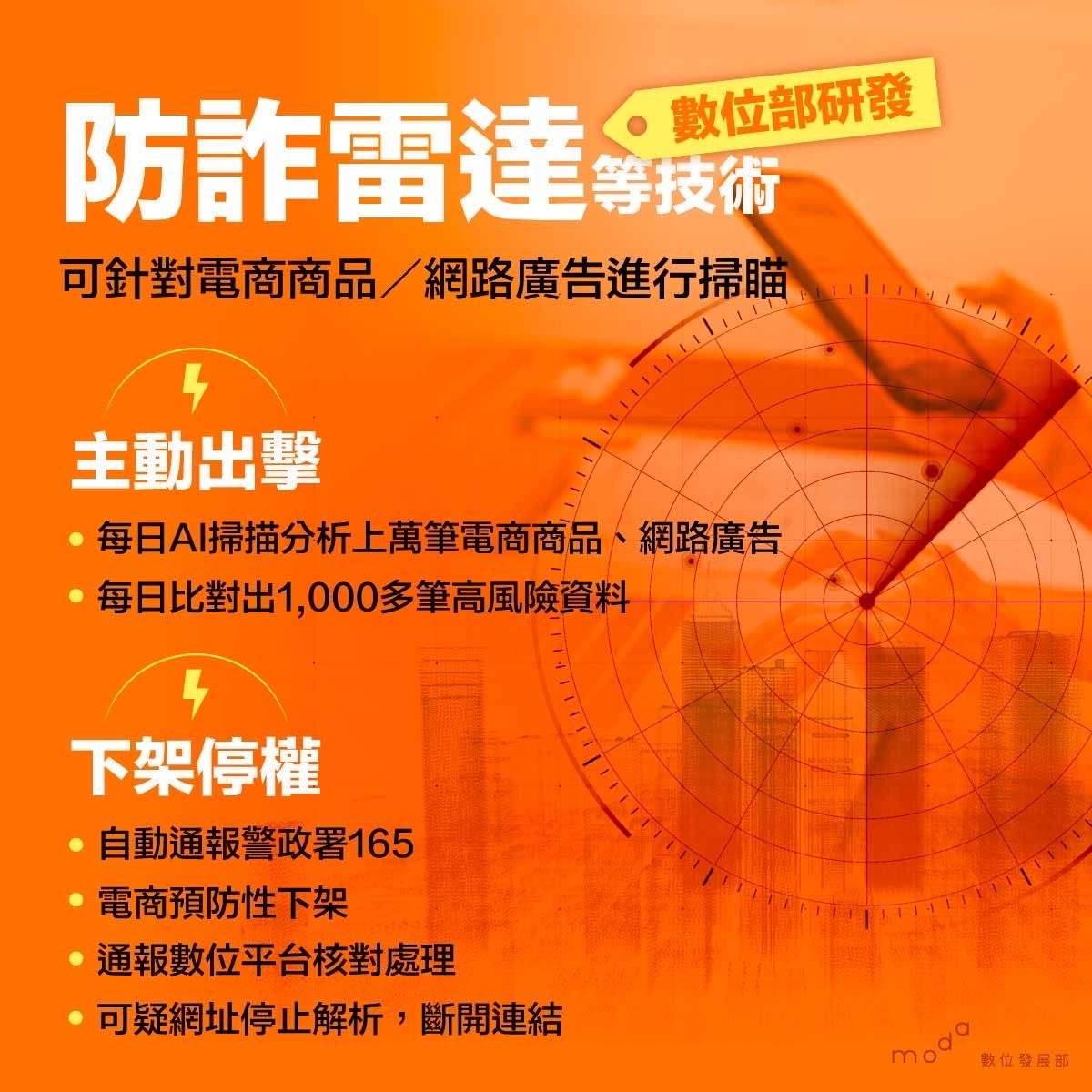The moda has developed fraud analysis and AI anti-fraud radar tools, which daily detect over a thousand fraudulent advertisements and e- commerce products.
The moda is proactively combating fraud at its source by developing digital tools such as "Fraud Pattern Analysis" and "Anti-Fraud Radar." By using the AI training for anti-fraud warning models, The moda conducts extensive scanning, detection, and comparison of online advertisements and e-commerce products. Every day, it scans tens of thousands of items, detecting and matching over 1,000 suspicious targets. It automatically notifies law enforcement agencies or digital platforms and e-commerce sites to proactively remove them, effectively blocking fraud at its source. Major e-commerce platforms under the jurisdiction of The moda have not been listed as high-risk stores in the National Police Agency (Ministry of the Interior)'s 165 Anti-Fraud Network announcement for five consecutive months since October last year.
The moda stated today (14) that it is commitment to provide businesses with a healthier digital trust environment, ensuring that people can enjoy convenient digital lifestyles without worries about fraud. In response to the constantly evolving tactics of fraudsters, The moda has outlined a three-stage approach, including the discovery of fraudulent information, public-private cooperation in prevention, and inter-agency collaboration for reporting. Through these efforts, The moda aims to offer diverse anti-fraud tools and technologies to assist businesses in more efficiently preventing and detecting fraud using digital technologies such as AI. By targeting the source, they aim to reduce the occurrence of suspicious online advertisements or stores, thereby lowering the chances of people falling victim to fraud.
The moda has pointed out that, in terms of online advertising, The Administration for Digital Industries utilizes "fraud pattern analysis" technology. It automatically scans over 10,000 online advertisements daily and conducts pattern classification, risk assessment, and fraud behavior analysis. From this process, they identify approximately 1,000 high-risk fraudulent advertisements and automatically report them to relevant cooperative agencies, including the National Communications Commission, the National Police Agency's 165 Anti-Fraud Network, and the Taiwan Network Information Center (TWNIC). These agencies then take further measures to combat fraud. For example, they may notify d
igital platforms to handle the issue or TWNIC may activate DNS RPZ to stop resolving fraudulent domains, rendering fraudulent URLs inaccessible. These actions effectively enhance the efficiency and capacity of cooperative agencies and platform operators in dealing with fraudulent advertisements.
In terms of e-commerce products, the "Anti-Fraud Radar" developed by The Administration for Digital Industries utilizes AI technology. It can set keywords based on recent popular products (such as baseball game tickets) and common fraud tactics (such as rapid increase in product ratings), and then conducts extensive scanning and matching through anti-fraud warning models. This enables rapid identification of suspicious fraudulent products and compiles them into a warning list. Currently, over 3,000 new products are scanned daily, with an average of approximately 140 high-risk products identified. From July of last year (2023) to February of this year, nearly 900,000 items have been scanned, detecting 27,000 high-risk products. This information is provided to e-commerce platforms for review and proactive removal to reduce the chances of people encountering fraudulent activities.
The moda explained that the principle behind the Anti-Fraud Radar primarily involves establishing and training an AI model for risk analysis and assessment based on patterns from past fraud cases. For instance, it has been observed that most fraudulent products tend to have high prices and are easily marketable, particularly high-value items such as luxury bags, unlocked mobile phones, laptops, etc. By continuously adding new patterns of fraud into the database used for AI model training, the analysis model can become more precise in identifying fraudulent activities.
The moda aims to establish a secure and trustworthy online environment for e-commerce platforms and the public through the development of digital trust tools and technologies. In the future, it will continue to strengthen public-private cooperation by sharing and utilizing suspicious fraud information. This collaboration will enhance the overall anti-fraud capabilities of the industry, safeguarding consumers and businesses from falling victim to fraudulent activities.
